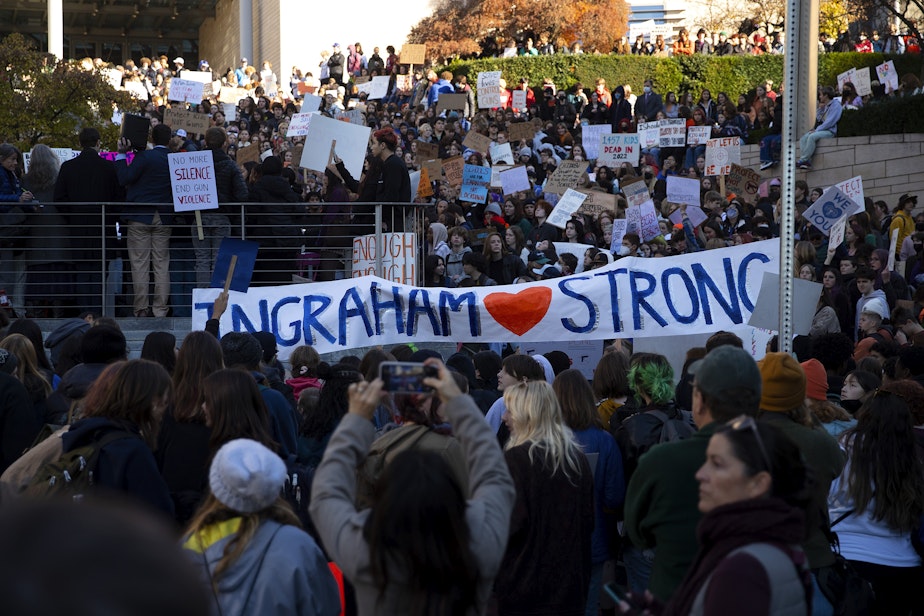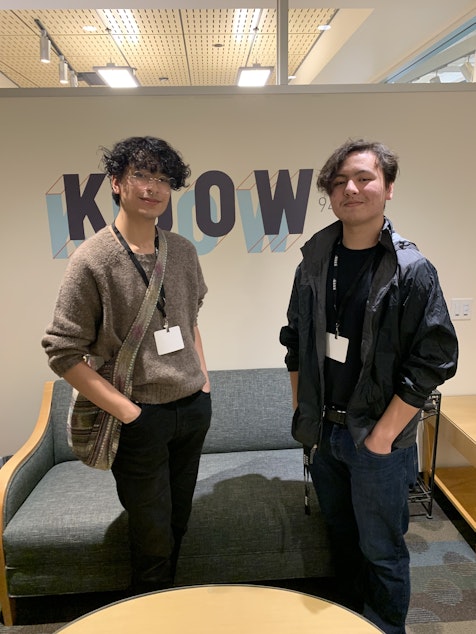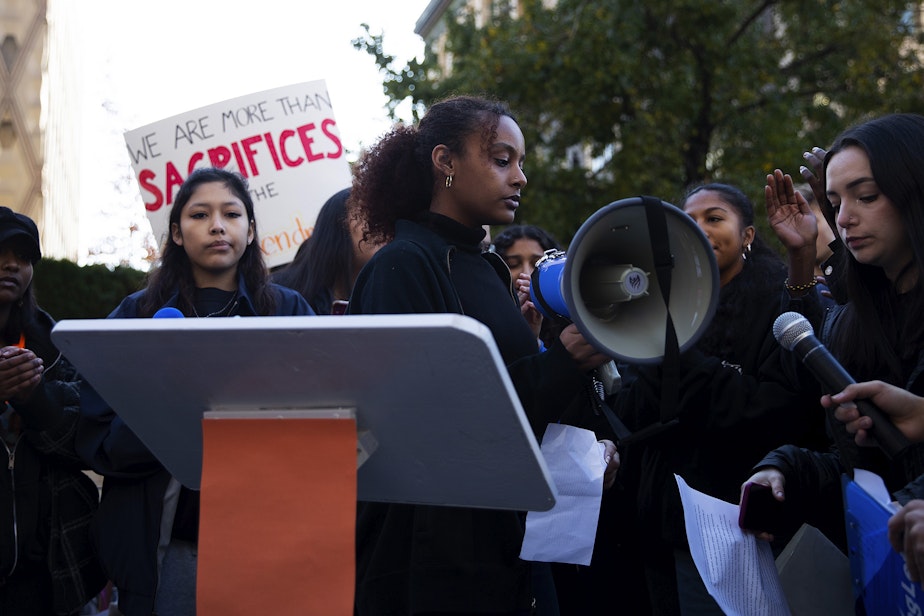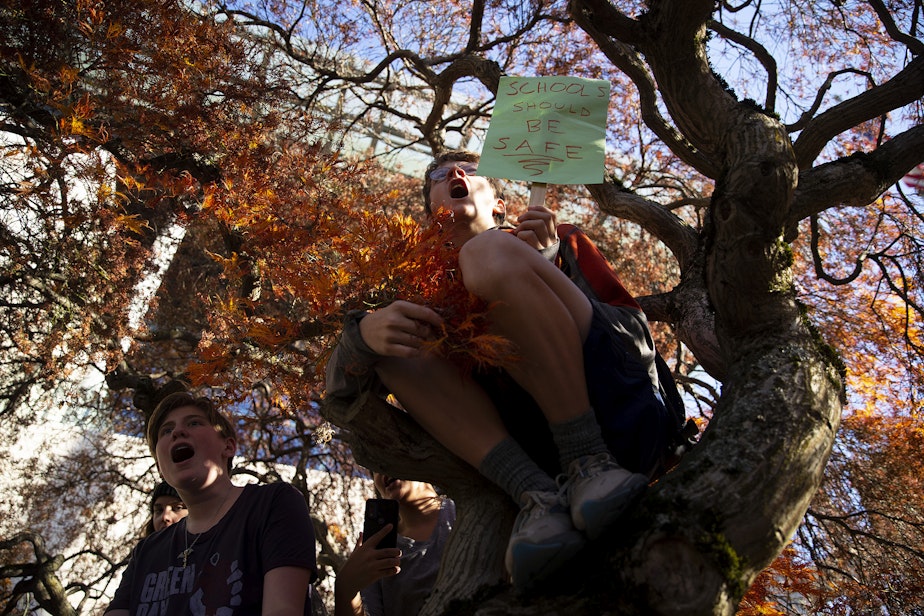How local youth are taking on school gun violence

O
n the morning of Nov. 8, 2022, Saeran Dewar made her way to Ingraham High School in Seattle’s Haller Lake neighborhood. It was a normal Tuesday, only a few weeks into her senior year. During her second-period statistics class, the school went into lockdown.
“At first, everyone was just sort of frozen and confused, because we hadn't heard anything,” Dewar said.
The protocol of lockdown drills was familiar, though. The class turned off the lights, locked the door, and lay down on the floor.
“It was through sort of communication with other students, over text, that we realized: ‘Oh, somebody actually got shot in the building,’” Dewar said. “And then you hear the sirens outside the building, and it gets really, really real.”
No one in the classroom knew where the shooter was – they could have been in the hallway outside, looking for a way in. Dewar began crying, muffling the sound with her fleece to avoid drawing attention to the room. Her classmates, some she’d only known a few weeks, tried to comfort her.
Gun violence and the threat of school shootings has become a presence in the life of students like Dewar across the U.S. The shooting at Ingraham was one of 303 shootings last year, according to data from the K-12 Shooting Database.
“We treat it almost like a fire or an earthquake,” said Hayden Andersen, a youth reporter in KUOW’s RadioActive program and senior at Chief Sealth High School in Seattle. At the start of every year, Andersen’s teachers go over the protocol for earthquakes (get under a desk), fire (file out in an orderly fashion), and active shooter situations.
“Get out of the building as fast as you can,” he said. “I think that particular phrase is one that stuck with me. It's not a specific direction. There's no particular protocol. It's just: Here's the nearest exit. Run.”

Andersen and fellow youth reporter Antonio Nevarez, a freshman at Seattle Pacific University, looked into the reforms local youth activists are pushing for in the wake of the shooting at Ingraham last fall. They shared their findings on KUOW’s “Seattle Now.”
Mental health in Seattle Public Schools
Mental health is a central issue for youth interested in addressing gun violence in schools.
“The data demonstrates that the vast majority of school shootings perpetrated by a student are perpetrated by students who are themselves suffering from anxiety, or depression, or schizophrenia,” Dewar said.
In the wake of her experience at Ingraham, Dewar has become more active in advocating for gun violence prevention. She is a founding member of Ingraham for Gun Safety, a group that started after the shooting at Robb Elementary School in Uvalde, Texas, last May.
One change Ingraham for Gun Safety would like to see is including dialectical behavioral therapy (DBT), in health classes required for students to graduate. The practice teaches skills to help manage emotions.
Another point of concern for youth advocates is access to mental health counseling.
“Prior to the shooting, we only had one mental health counselor for our 1,400 students, which is just unacceptable,” Dewar said. “There's a large population of students at Ingram who cannot afford private counseling.”
Following the shooting, thousands of Seattle students walked out of classes and protested in front of City Hall. Their goal was to put pressure on the district to increase funding for mental health.
It worked. In November 2022, the Seattle City Council allocated an additional $4 million for mental health support in schools, including counseling.

But Natalya McConnell, a leader of the Seattle Student Union, says that still isn’t enough to address student mental health needs.
“We demanded $9 million,” she said, “and I think that's definitely possible, especially in the next budget season.”
The district didn’t provide details on what would need to happen for more funding to be allocated toward mental health counselors.
Instead, SPS Mental Health Program Manager Stephanie Edler encouraged youth to focus on initiating change on a smaller scale at their schools, by joining student organizations and clubs.
She told Nevarez youth can also work towards de-stigmatizing mental health, especially in their social networks.
“I think part of decreasing that stigma is allowing it to be a topic of conversation that doesn't feel so taboo,” Edler said.
Schools can play a role in that shift, she said, potentially through health education and curriculum around social emotional learning. She was supportive of the idea of incorporating dialectical behavioral therapy into health classes.
“I think it's amazing that DBT was something that stuck out to them,” Edler said.
Gun control
Another central demand from youth activists is more restrictions on gun ownership and storage. McConnell from the Seattle Student Union is in favor of widespread gun control.
Dewar said Ingraham for Gun Safety has a more specific demand: A state law requiring every gun sold to come with a safe storage device.
Washington currently mandates that firearm retailers offer a safe storage device with every purchase, but not that the customer takes it. Renee Hopkins, CEO of the Seattle-based Alliance for Gun Responsibility, told youth reporter Nevarez that there’s another approach.
Initiative 1639, passed by voters in 2018, includes what’s called an access prevention law.
“The way the law works is that if you own a firearm and it falls into the hands of a person who then causes harm either to themselves or others with that firearm, you can be criminally prosecuted,” she told Nevarez.
It’s an alternative to a law like Dewar described, which requires safe storage.
“Of the two approaches, the access prevention actually has more science behind it, that it is more effective,” Hopkins said.

Even though the Alliance for Gun Responsibility doesn’t support more safe storage rules, Nevarez said he was inspired by the number of ways the organization encourages youth to get involved in advocacy.
“It's very easy for many young people to feel like there's no adults that are listening. And for me, it means a lot that there are still people that are listening to children, to teenagers, and to youth,” he said.
Still, Nevarez and Andersen said it’s a difficult thing to accept that adults aren’t going to solve these problems without youth applying pressure.
“I think that in some ways, it is profoundly depressing as a young person, that it was necessary to talk about this,” Andersen said. “We should be focused on our grades, our friends, our future. We should not be focusing on if we're going to have that future at all.”
Editor's note: This story has been updated to correct the spelling of Natalya McConnell's name.





